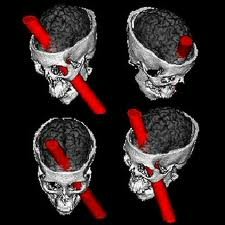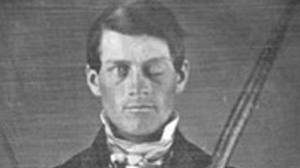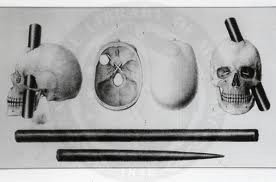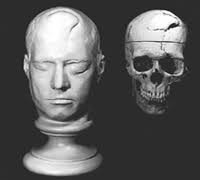by Alberto Carrara | translated by Adrian Lawrence
What would happen to a man if a spear pierced through his face entering through his jaw and exiting through his skull?
We would probably say that this human being in the worst case scenario would die a victim of the accident. Or perhaps you could expect him to go into a coma, possibly reversible, although with multiple injuries. After a long period of convalescence, with luck and all the help of modern medicine, this man might be able to recover from the injury yet with various physical disorders. This would be the happy story.
But rarely in the history of medicine could one imagine the eccentric case of Phineas Gage (1823-1860). September 13, 1848 marks an occasion of great significance in the history of neuroscience. Twenty-five-year-old foreman, Phineas Gage, working on the construction of railways in northern New England (Vermont) suffers a serious accident. On the account of an explosion, an iron beam three feet long and three centimeters wide penetrates part of his face, piercing his jaw at the zygomatic arch, then passing through the cranial cavity and finally, breaking the frontal bone.
 His friends were greatly surprised when Gage, who didn’t die on the spot, after initial and understandable dizziness, came to himself to such a point that he could narrate in minute detail the accident to the doctor who attended him in first aid. Gage lost a large amount of prefrontal cortex, but survived the injury and regained his physical health.
His friends were greatly surprised when Gage, who didn’t die on the spot, after initial and understandable dizziness, came to himself to such a point that he could narrate in minute detail the accident to the doctor who attended him in first aid. Gage lost a large amount of prefrontal cortex, but survived the injury and regained his physical health.
The story, however, does not end here. Phineas Gage was never again the same Gage as in the moment preceding the accident. How come? Although there had been no sensory or motor injuries, nor had they detected changes in the language or sensory memory, Phineas Gage’s personality changed noticeably. John Harlow (1819-1907), the doctor who treated Gage in the Massachusetts General Hospital in Boston, collected his remarks in a historical article about this patient.
Harlow described his patient as follows: “His physical health is good, and I am inclined to say that it has recovered … The balance or equilibrium, so to speak, between his intellectual faculties and animal predispositions seems to have been destroyed. He is impulsive, irreverent …, shows little deference to his colleagues, is intolerant to their limitations and the advice they offer him when it doesn’t match up with his desires. He is sometimes very stubborn, but most of all, whimsical and wavering. He makes many plans to better himself for the future, which he ends up leaving in nothing other that the organizational stage … In this regard, his mind has completely changed to the point that his friends and acquaintances say: he isn’t Gage anymore” (Principles of Neuroscience, Elsevier, Madrid 2003, p. 519).
 This story marks the first concise scientific description of the main symptoms associated with the destruction of the prefrontal cortex in a human. After the accident and two months in the hospital, Phineas Gage lived for more than ten years and died of epilepsy at thirty-seven years of life. But Gage was already someone else. But who?
This story marks the first concise scientific description of the main symptoms associated with the destruction of the prefrontal cortex in a human. After the accident and two months in the hospital, Phineas Gage lived for more than ten years and died of epilepsy at thirty-seven years of life. But Gage was already someone else. But who?
Today, a few die hard reductionist scientists speak of the discovery of the area or part of our brain responsible for our moral judgments. Gage’s personality changed because his brain changed. Indeed, after Gage’s death, his skull was donated to the Warren Anatomical Museum of Harvard University. Numerous studies came to very accurately identify the area of his brain damaged by the incident. This area was mainly the left part of the ventral medial prefrontal region.
Although this area of the cerebral cortex is related to personality and numerous scientific studies increasingly show it to be the best candidate for the neural correlates associated with moral behavior, this does not mean or imply that this area is the cause of morality in man.
Juan Lerma, a prestigious Spanish neurobiologist and director of the Institute of Neurosciences of Alicante, says that neuroscience is teaching us to see that we humans “are what our brain determines us to be, and this will have an influence in education or in the management of violence” (interview of Diario Médico, Friday January 4, 2008). This way of thinking, quite widespread in our society, considers our brain as the biological structure that on the one hand defines the ultimate essence of being human, and on the other presents itself as the factor to shape our future. Many today tend to believe that we are our brain.
 Neuroscience research seems to bring with it a “plus”, as was well pointed out by José Manuel Giménez-Amaya and José I. Murillo from Navarra University (Neuroscience and freedom: An Interdisciplinary Approach, Scripta Theologica, vol. XLI, fasc. 1, January-April 2009, p. 26), that “adds the feeling of unmasking the most human part of man, and putting it under our control.” This kind of research is so attractive because it proposes to tackle the most ambitious goal of experimental science, namely: to explain rationally and empirically the great questions about our unique human condition.
Neuroscience research seems to bring with it a “plus”, as was well pointed out by José Manuel Giménez-Amaya and José I. Murillo from Navarra University (Neuroscience and freedom: An Interdisciplinary Approach, Scripta Theologica, vol. XLI, fasc. 1, January-April 2009, p. 26), that “adds the feeling of unmasking the most human part of man, and putting it under our control.” This kind of research is so attractive because it proposes to tackle the most ambitious goal of experimental science, namely: to explain rationally and empirically the great questions about our unique human condition.
There is no doubt, however, that current neuroscientific data are not even at the level to trace the overall functioning of our brain in its cognitive, affective, volitional, emotional, and memory processes. Scientifically and rationally speaking, therefore, one cannot “rely solely on these results to draw unitary conclusions about the actions of man” (Neuroscience and freedom: An Interdisciplinary Approach, Scripta Theologica, vol. XLI, fasc. 1, January-April 2009, p . 34).
The American philosopher Alva Noë, in his book entitled Why We Are Not Our Brain puts forward a balanced criticism of the certainties of neuroscience and the optimism so contagious that surrounds them. The idea that runs throughout the paper is that man is not his brain, the human being is not locked into its materiality, even biologically speaking, but “the phenomenon of consciousness, as well as life, is a dynamic process involving the world.” Man lives, de facto, outside his head.
Our moral capacities, our abilities to make and bring to fulfillment ethical judgments, need physical and biological structures which are intact. That is, the brain, and in a peculiar way, the left medial ventral prefrontal cortex, is the necessary condition so that humans can maintain moral behavior suitable to their nature. “As a window does not cause light, but is a necessary condition so that the light caused by the sunshine can enter and illuminate” a room, as says the anthropologist Lucas Lucas in his book Explicame la Persona, thus the causal relationship between morality and the brain is not that the brain organ is the cause of the morality of man, but an intact brain structure is the necessary condition so that man can express his morality (Explícame la persona, ART, Rome 2010, p. 64).
 Phineas Gage, after the injury, continued being the same person he was before, but the manifestation of his personality was altered by the pathological condition generated as a result of the accident that impaired his left cerebral cortex.
Phineas Gage, after the injury, continued being the same person he was before, but the manifestation of his personality was altered by the pathological condition generated as a result of the accident that impaired his left cerebral cortex.
In conclusion, together with the study of the chemical and biological processes of the human brain, so necessary in the understanding of its functioning, it is imperative that contemporary neuroscience broadens its horizons by integrating the plain observable data with a reflective understanding of the human person based on an integral philosophical-anthropological vision of man.
Scientists themselves perceive in the study of the human mind the need to distinguish between mind and brain, between the human person who acts morally and neurobiological factors that sustain his intellect, will, and affectivity, which form part of his actions. Science itself sees the great mystery of a human dimension that transcends mere brain physiology and that, after all, is the very foundation of our dignity as beings with a peculiar “position” in the cosmos.

